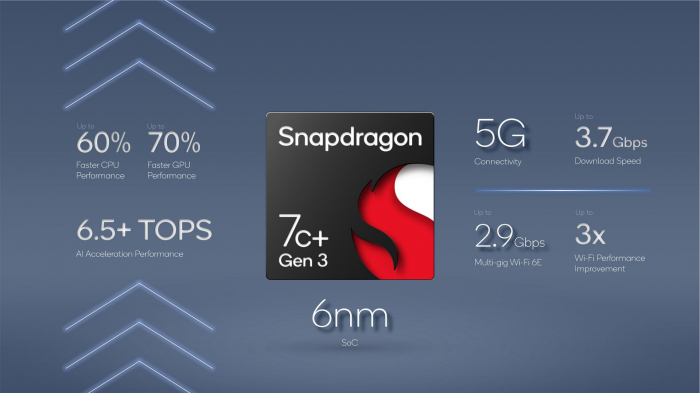Qualcomm is holding its annual Snapdragon Tech Summit event to showcase its new products. Among the debuts are the Snapdragon 8cx Gen 3 and Snapdragon 7c+ Gen 3 hardware platforms, which will find use in low-cost Windows and Chrome OS-based notebooks.
The Snapdragon 8cx Gen 3 replaces the Snapdragon 8cx Gen 2 and is a major upgrade over its predecessor. It is a platform built using 5nm process technology. A performance increase of 85% and a 60% improvement in energy efficiency are claimed. At the same time the new Adreno GPU is 60% faster than the Snapdragon 8cx Gen 2. The chip also promises to deliver over 29 TOPS in AI performance.
The chip has eight processor cores, four of which are Cortex-X1 cores with a peak frequency of 2.995GHz. Another four Cortex-A78 cores are overclocked to 2.4GHz. Inside is a Snapdragon X65 5G modem that delivers data speeds of up to 10Gbps. If desired, companies can order this chip with a Snapdragon X55 5G modem with speeds up to 7.5Gbps or a Snapdragon X62 5G modem with speeds up to 4.4Gbps. The platform also uses a 2x2 Wi-Fi FastConnect 6900 with Wi-Fi 6E support at up to 3.6Gbps.
In parallel, the Snapdragon 8cx Gen 3 offers noise cancellation algorithms for video conferencing with high sound quality.
The Snapdragon 7cx + Gen 3 chipset is based on 6nm process technology. The platform includes four Cortex-A73 cores clocked at 2.4GHz and a quartet of Cortex-A55 cores clocked at 1.5GHz peak. Qualcomm claims the chip is 60 per cent faster than the previous model and the graphics subsystem has received a 70 per cent boost in power. In artificial intelligence and machine learning, the chipset produces 6.5 TOPS. There is support for Wi-Fi 6E and fifth-generation networks thanks to the built-in Snapdragon X53 modem.

Devices with Snapdragon 8cx Gen 3, and Snapdragon 7c + Gen 3 will hit the market in early 2022. The new devices are not as powerful as Apple's M1 series, but they could become an interesting alternative to Intel and AMD products, especially due to their lower power consumption and thanks to their 5G support.



You must be logged in to post a comment.